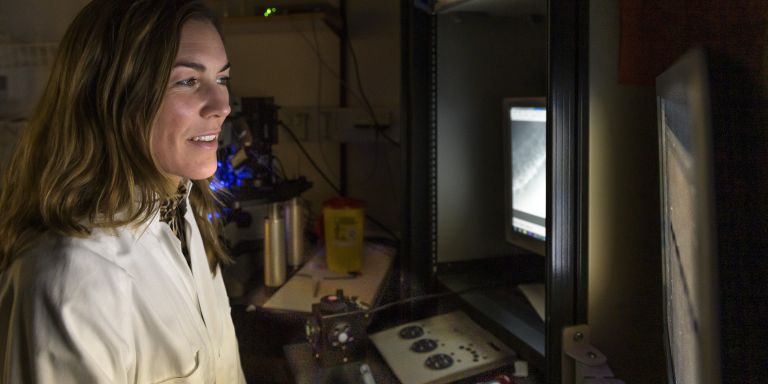
Daniella Rylander Ottosson
PhD in medicine
Wallenberg Academy Fellow 2021
Institution:
Lund University
Research field:
Creation of new neurons by genetic reprogramming


Wallenberg Academy Fellow 2021
Institution:
Lund University
Research field:
Creation of new neurons by genetic reprogramming
Ten years ago Rylander Ottosson was a member of a research team led by Malin Parmar, a prominent Parkinson’s researcher at Lund. Parkinson’s breaks down nerve cells that produce dopamine, and Daniella was given the task of trying to create dopamine cells by genetically reprogramming another type of brain cells – glial cells. It didn’t work at all. Despite her best efforts, the glial cells developed into interneurons instead.
This was of no use to the researchers trying to cure Parkinson’s. But it turned out that interneurons represented a research field all of their own – one that was just as interesting to explore. In 2017 Rylander Ottosson set up her own research team with the aim of creating interneurons by reprogramming. The goal is to develop new therapies for neuropsychiatric and neurological diseases.
“Interneurons are found throughout the brain. They play a key role when neurons communicate with each other, and help to amplify and moderate the signals. Damage to interneurons has serious implications for the entire brain network.”
The interneurons that Rylander Ottosson is working on are called parvalbumin interneurons. Tissue samples from deceased patients, EEG scans and genetic studies have revealed damage to neurons of this kind in people with conditions such as schizophrenia, autism spectrum and epilepsy. But although a fair amount of research has been done on interneurons, it has been difficult to generate parvalbumin interneurons in the laboratory e.g. from stem cells.
The Lund researchers have shown that reprogramming strategy seem to work much better. Harmless virus particles are used to insert selected genes in glial cells, causing them to change which of their own genes are active.
All cells in an organism contain the same genes. The genes that are active in a specific cell determine what kind of cell it becomes. In this way the researchers in Lund have managed to reprogram glial cells from mice and humans so they are transformed into interneurons.
They are now refining their reprogramming methods, and conducting further studies into the effect the newly created interneurons have on symptoms and how they connect to surrounding brain cells.
“We know we can insert human interneurons into a mouse brain, and get them to survive and disperse there – and they seem to establish contact with surrounding cells. That alone is a major discovery.”
The next step is to see whether it is possible to create human interneurons inside the brains of animals, which is what the scientists eventually want to be able to do in the human brain. The researchers are using multiple mouse models – for example mice that have been genetically modified to display symptoms resembling psychiatric conditions in humans. Taken individually, the models are fairly blunt instruments, but in combination they provide a clearer idea of whether the new cells are of benefit.
“We may be on to a completely new way of creating a cell therapy for neurological conditions that are hard to diagnose and for which there are currently no effective therapies. In the case of Parkinson’s for instance, we know exactly which neurons have died and need replacing. I see interneurons more as a tool for repairing the brain’s signal system.”
But many challenges lie ahead. It takes a long time to culture the glial cells that are to be reprogrammed – only a small proportion of them develop into parvalbumin-interneurons, and they mature slowly. It requires patience, persistence and resources.
“Brain research appeals to me because it's a bit abstract – there's so much we don't know about the brain. At the same time, it is so central, an organ that houses our entire identity and personality.”
Even in high school Daniella was curious about the human body. She considered training to become a doctor, but realized that contact with patients was not what most appealed to her; it was the chance to explore scientific questions and gain a real understanding of them.
“And I ended up researching on the brain, which we often don’t understand at all,” she says wryly.
For a long time she had no plans at all to become an academic researcher. When she began her postgraduate studies the idea to go half way – to a “licentiate” degree, and then work in industry. Research seemed boring; she imagined it was lonely work and did not think it would suit a sociable person like her.
“But I got so involved in multiple projects – it was like doing a jigsaw puzzle, and I felt I couldn’t stop halfway through. And I also realized that research is in fact a highly sociable job.”
The work involves a large measure of uncertainty. No one knows which experiments will be successful – time and time again a new approach is needed to keep a project alive. But as Rylander Ottosson says, researchers learn to live with the uncertainty:
“I like nearly everything I do. Planning and performing experiments, attending conferences, writing applications and articles, and teaching. It’s so flexible and varied. I have the best job in the world!”
Text Lisa Kirsebom
Translation Maxwell Arding
Photo Kennet Ruona